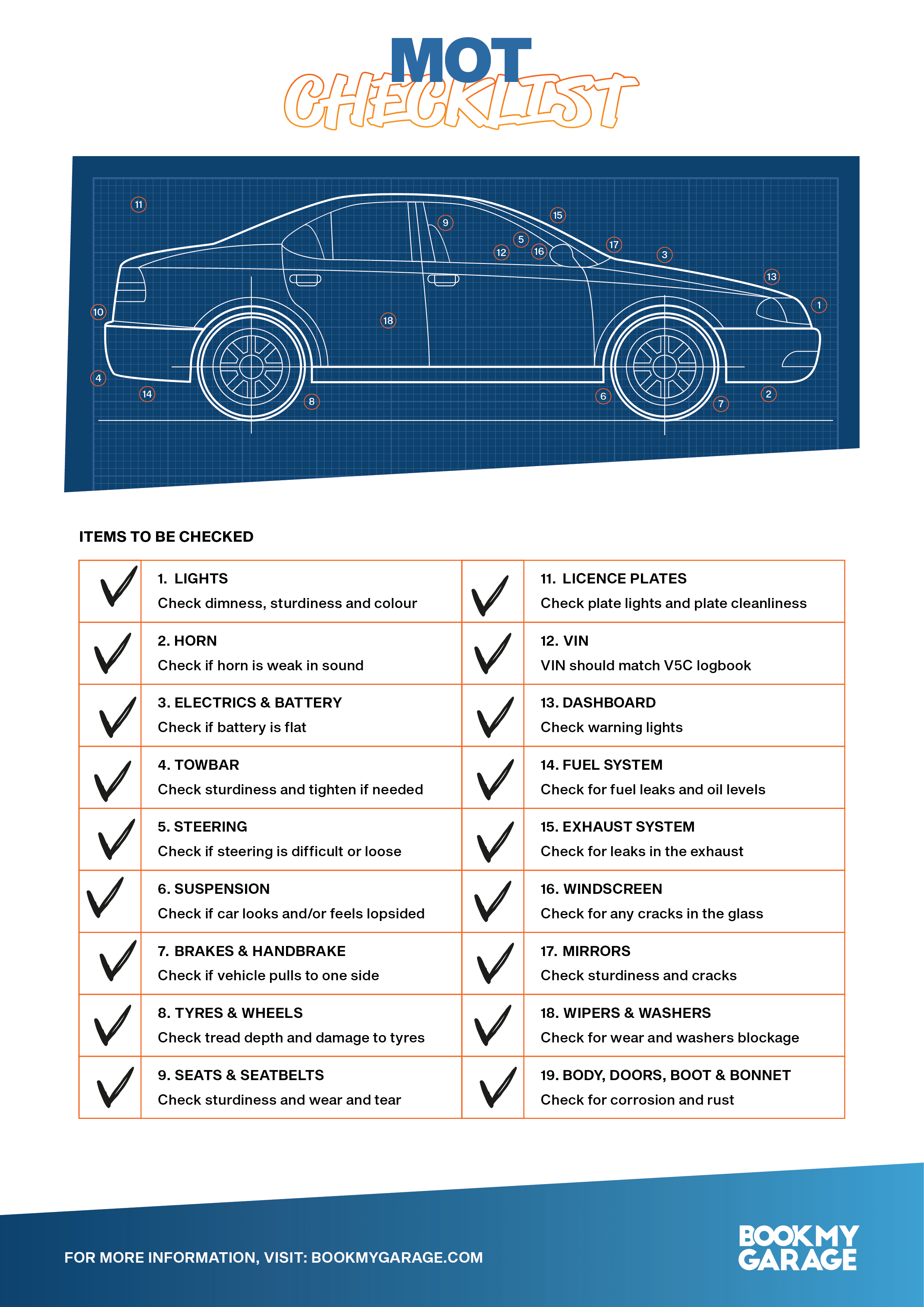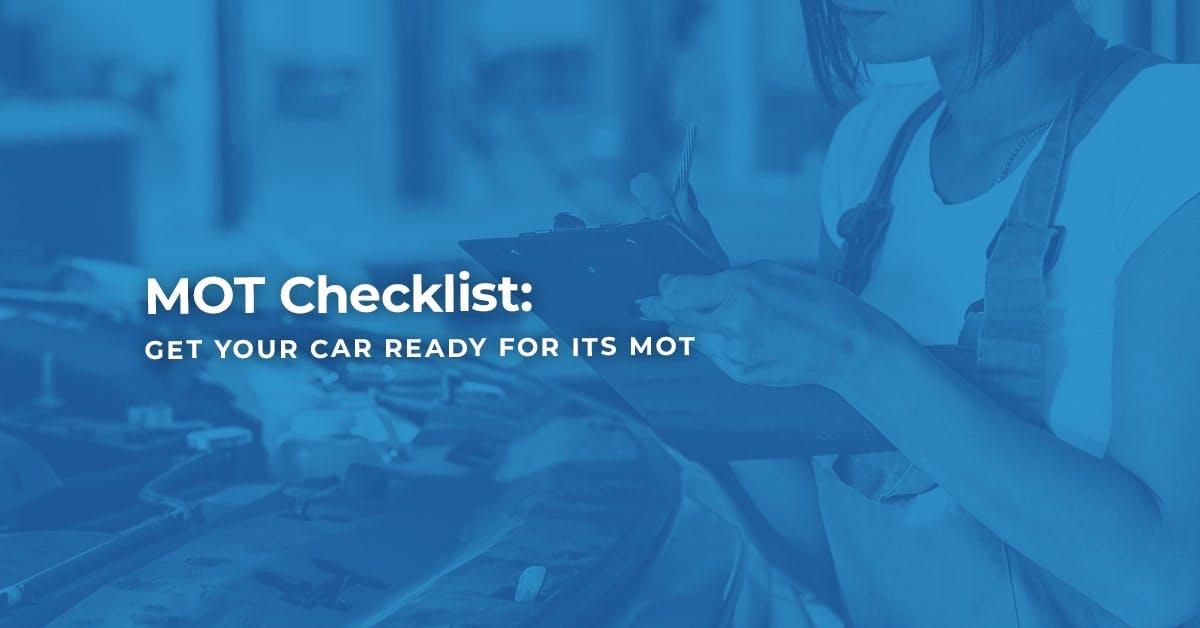To give your car the best chance of passing its MOT first time, there are a few quick pre-MOT checks you can easily do yourself.
Seemingly insignificant issues like broken bulbs or dirty registration plates can actually lead to MOT failure.
That’s why it is so important that you refer to an MOT checklist and have any issues fixed ahead of an upcoming test.
Read on and benefit from the helpful pre-MOT checks listed in this blog.
Page Contents
- MOT Checklist
- Lights
- Horn
- Electrics and Battery
- Towbar (If Applicable)
- Steering
- Suspension
- Brakes and Handbrake
- Tyres and Wheels
- Body, Boot and Bonnet
- Licence Plates
- Vehicle Identification Number (VIN)
- Fuel System
- Emissions
- Exhaust System
- Windscreen and Mirrors
- Wipers and Washers
- Seats
- Seatbelts
- Doors
- Dashboard
- Which Pre-MOT Checks Can I Do Myself?
- Why Should I Book a Pre-MOT Check?
MOT Checklist
An MOT checklist includes a wide range of checks that an MOT tester will carry out to ensure that your vehicle is roadworthy and meets set legal requirements.
You can find an example of the DVLA MOT checklist on the gov.uk website.
By referring to an MOT checklist as you carry out this visual inspection, you can ensure that all of the components in your vehicle which will be checked stand a better chance of passing the test.
Or you could book a pre-MOT check at a local garage to have this done professionally, giving you a better chance of passing the MOT test first time.
We’ve put together a handy BookMyGarage MOT checklist to make this process even easier for you.

Lights
Did you know that lights are the most common cause of MOT failure?
As part of your regular car maintenance, you should check that all of your bulbs – front, rear, fog, brake and indicators – are working well.
Even your number plate light needs to be in good working order.
Switch all the lights on – inside and out – and walk around your car. Ask someone to stand behind the vehicle to check the rear brake lights as you put your foot on the brake pedal.
If the bulbs are dim or dead, replace them as soon as possible.
You can get cheap bulbs at the majority of automotive retailers and fit these yourself. Some will even install the bulbs for you, for an additional charge.
You should also look out for any unsecured light mounts, as this can lead to MOT failure.
Make sure all your lights are the correct colours, too, as you follow your MOT check list.
Horn
Your car’s horn is designed to be loud enough to warn other drivers of dangerous situations.
To check your horn, press firmly and listen.
If it sounds weak or quiet, then book an appointment at your local garage and have this fixed.
Electrics and Battery
If your battery is flat or won’t hold charge, then your car will struggle to start.
You can book a free battery inspection at a local garage to fix the issue in advance of your MOT.
Towbar (If Applicable)
You should check that your towbar is secure and in good condition.
You may need to tighten, replace or repair it if it is damaged before your MOT.
Steering
Your steering should feel secure, and the wheel should be easy to turn.
If steering is difficult or feels loose, you should book an inspection right away.
Suspension
When you press down on the side of your bonnet, it should rock back into position immediately.
If this is not the case – or your car looks and feels lopsided – you should book a suspension repair ahead of your MOT.
Brakes and Handbrake
You should check that your vehicle doesn’t pull to one side when braking.
If it does, you need to have this look at by a professional mechanic.
If you have alloy wheels, then you may be able to perform a visual inspection of the braking system without removing the wheel.
Look for excessive brake pad wear, and for pitted brake discs – if you notice either issue, then your brakes will need to be replaced.
The handbrake should hold the car firmly in place – you should book a brake repair if there is no resistance when you engage it.
You should also inspect your brake fluid reservoir to see if the fluid is low or looks spoiled, in which case you should book a brake fluid change.
Given that spoiled brake fluid can impact your car’s stopping distance, it is considered a dangerous fault during an MOT – so you need to have this fixed before your test.
Tyres and Wheels
Your tyres should be inflated to the correct tyre pressure and have sufficient tyre tread around the whole tyre.
You can perform the 20p tread depth test, and put air in your tyres if needed.
Be sure to look for any damage, cracks, exposed cords or punctures. These are dangerous faults, meaning you will need to have new tyres fitted before your MOT.
Body, Boot and Bonnet
All bodywork should be free from corrosion, rust and sharp edges.
If your car has been involved in an accident, then it may be worth repairing the bodywork to avoid a dangerous MOT fault.
The boot and bonnet lids should lie flat and close properly.
Check that you can open and close both as part of your pre-MOT checks.
Licence Plates
Your licence plates should be correct and clean to pass the MOT.
You can check the Drivers and Vehicle Licencing Agency (DVLA) advice on what your licence plates should look like if you’re unsure.
Make sure that the licence plate light works as well. If not, you will need to replace the bulb.
Vehicle Identification Number (VIN)
All vehicles registered after 1980 have a vehicle identification number – or VIN – somewhere on the vehicle.
You can check that yours matches the VIN in your vehicle handbook as you follow the MOT checks list.
If a vehicle is stolen or has been modified, then it may have had its VIN removed. That means that if yours is removed or damaged, this will lead to MOT failure.
You should report this to the DVLA.
If you can’t prove the vehicle’s original VIN – say you don’t have the original vehicle handbook – you will have to apply for a replacement VIN.
Once this has been approved, issued and stamped, you can apply to register the vehicle.
Fuel System
Any oil or fuel leaks should be fixed as soon as possible.
You need adequate fuel and oil levels so that the emissions test can be carried out.
To check your oil levels, you can remove the dipstick from the engine and give it a wipe.
Put it back in the engine and then remove it again. The oil level should lie between the minimum and maximum marks – check this when your car is parked on an even level.
Emissions
Look out for excessive or blue smoke, or a rattling coming from your exhaust.
These often indicate an issue with the exhaust system, which could be increasing your car’s emissions.
If you suspect this, book an exhaust repair immediately.
Exhaust System
Be aware of any fuel or oil leaking from the exhaust, as this could signal that the spark plugs or glow plugs are not warming and burning fuel properly.
An increasing number of cars have failed their MOTs as a result of an exhaust problem in recent years – make sure you have any exhaust issues fixed before your test.
Windscreen and Mirrors
Anything that obstructs the driver’s view of the road – think sat nav mounts, stickers and air fresheners – will result in a fail.
You should have any chips or cracks in the windscreen repaired as soon as you notice them, as a windscreen replacement can be an expensive job.
Any chip of crack on the windscreen which is larger than 40mm will result in MOT failure – and any damage larger than 10mm in the area covered by the wiper on the driver’s side will also lead to a fail.
As for your mirrors, they must be secure and free of any cracks.
A cracked or smashed mirror can lead to MOT failure – you should have damaged mirrors replaced before the test.
Whilst you can find replacement mirrors for your car’s make and model online, you should be wary of ‘self-adhesive’ ones, as they are likely to fall off again in no time at all.
Wipers and Washers
Made sure that your windscreen washers work, and that your aren’t showing any signs of wear or splitting.
If your washer feed is blocked, then you will have to address this before the MOT test.
Please know that you can fail your MOT if you don’t have screen wash – so remember to top up the bottle as part of your checks in advance of the test!
Seats
During an MOT, the tester will check that the driver’s seat can be adjusted, and that all seats are securely fitted.
The seat backs need to be able to be fixed in the upright position.
If you notice that your seats don’t seem secure, then you should have this looked at ahead of the test.
Seatbelts
Check all the seatbelts for tears or damage, as well as ensuring they restrain safely.
To do this, sit in each seat and jerk forward suddenly to mimic sudden braking.
If a seatbelt doesn't immediately catch you, there's a fault which needs fixing before your test.
Clip each seatbelt in position and make sure they fit securely in the buckle as well.
Doors
The door latch needs to be secure in the closed position.
The front doors must open from inside and outside the vehicle, and the rear doors need to open from outside the vehicle.
Dashboard
Whilst your warning lights should all come on when you switch the ignition on, if any of the warning lights on your dashboard stay lit when you start driving, you should have the related issue resolved ahead of your test.
You should also check that your speedometer and rev counter accurately reflect your speed.
If not, you should book an electrical repair, as an inaccurate speedometer can lead to MOT failure.
Which Pre-MOT Checks Can I Do Myself?
When it comes to carrying out a pre-MOT check, there are a few quick, key checks you can do to make sure your vehicle is ready for its MOT.
You can watch this video to learn how to prepare your vehicle for an upcoming MOT test.
Give your car a good clean – of both the interior and exterior – and empty the boot of any excess clutter.
Clean your number plates whilst you’re at it – the MOT tester needs to be able to read them during the examination.
If you notice any tears in your windscreen wipers, then they will need to be replaced before the test.
Likewise, all of your lights need to be working well.
Ask someone to stand outside of the car as you turn the lights on to check they are working as expected.
You can carry out the 20p tyre tread depth test, and should check your tyre pressure too to make sure your tyres are ready for the MOT.
Then there’s screen wash, brake fluid, and oil – fluids like these must be appropriately topped up ahead of the test.
Give your car’s horn a quick honk and make sure that your mirrors are intact.
Lastly, be sure to check that the Vehicle Identification Number (VIN) in your car’s V5C logbook matches your car’s bodywork.
Why Should I Book a Pre-MOT Check?
You can perform this visual inspection yourself if you feel confident enough doing so, but this is an inexpensive job which you can entrust to a professional.
Not only can booking a pre-MOT check increase your chances of passing the test, but it can also save you money in the long run.
You will likely not have to spend money on an MOT retest, as these checks should increase your chances of passing first time.
By following the MOT check list yourself or booking a pre-MOT test, you can reduce the likelihood of a serious car problem occurring in the future and requiring a costly repair.








No comments yet
Leave a comment